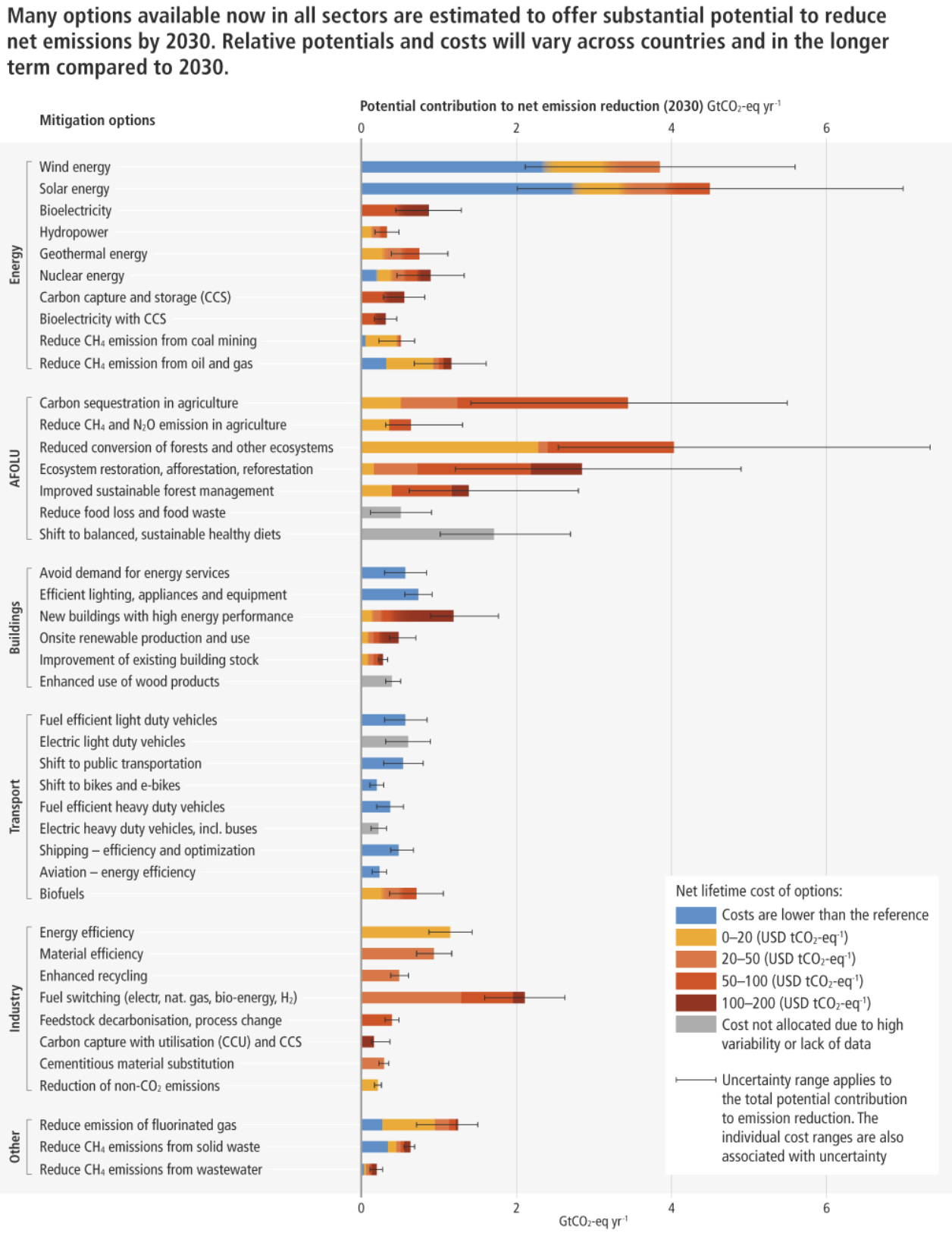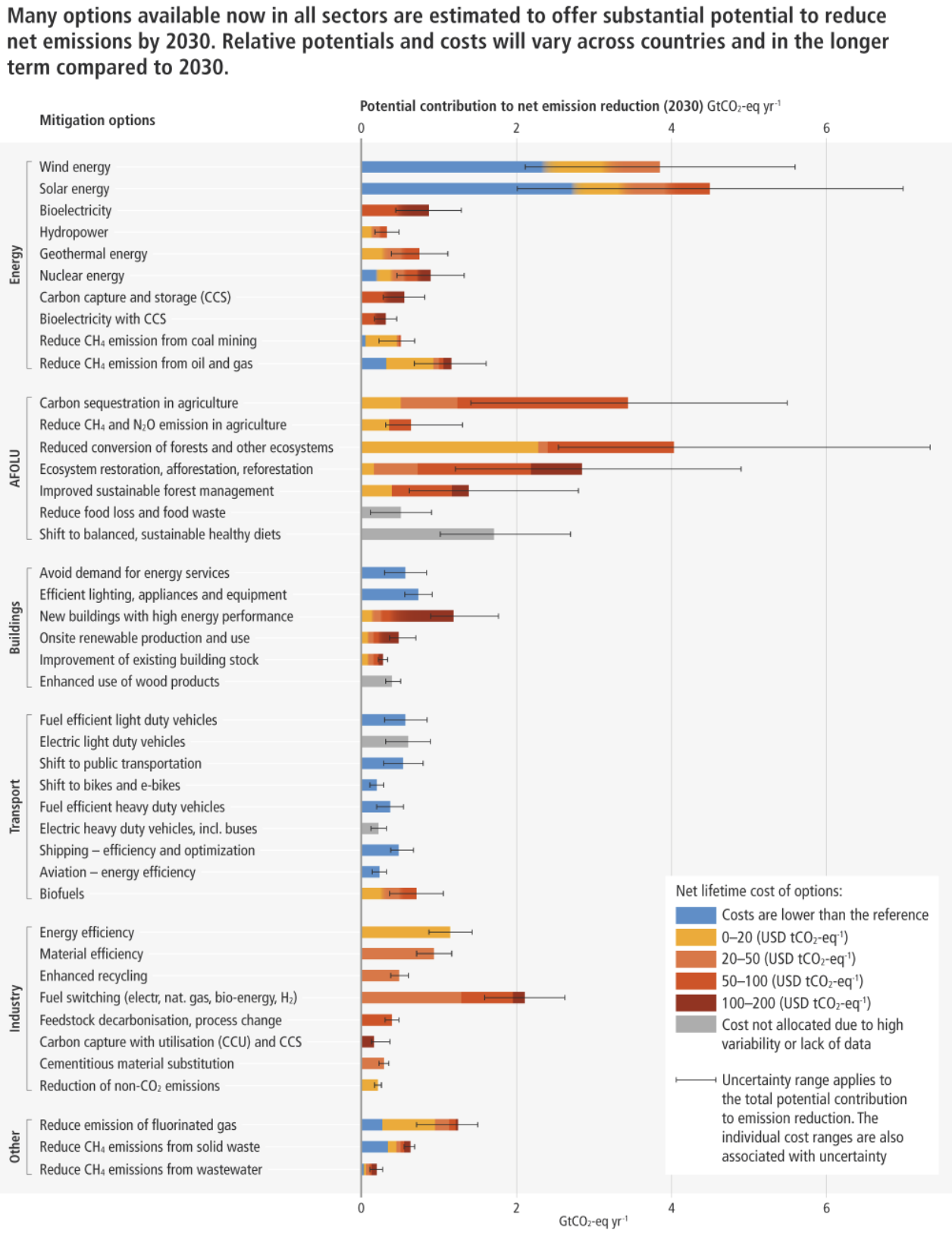|

Carbon
removal's hard problems

The United Nations Intergovernmental Panel on Climate Change’s
latest report sent
a stark alert about the world’s current emissions and temperature
trajectory. Within the document is a complex chart that
maps out dozens of technologies or practices which can reduce
emissions, their potential to do so this decade, and the economics of
deploying them.


Source:
IPCC Source: IPCC
The charts are color-coded. Anything blue is cost-competitive today;
anything in the range from light orange to dark red indicates a need
for investment beyond business as usual. Wind and solar energy are
winners in terms of cost and scale, with gigatons of potential
emissions reduction per year. So too are a half-dozen transportation
approaches. Industrial measures have significant potential, but carry
a high cost. Building applications, in particular energy services and
lighting, are in the money but others such as the rather broad
“improvement of existing building stock” are not.
At the bottom of the energy section is a small (in terms of 2030
potential) and angry (in its bright red colors) bar for carbon capture
and storage. It has limited emissions potential within this decade,
and it is expensive.
Just as the IPCC’s report dropped, Swiss carbon removal company
Climeworks AG announced it
had raised $650 million. This investment is by far the
largest in any carbon removal company. There is now twice as much
investment in this particular carbon capture technology in the first
four months of 2022 as in the prior four years.
Just as important as the amount of the investment is the size of main
investors. Partners Group AG manages $127 billion; Baillie Gifford,
more than $450 billion as of December 2021; GIC, Singapore’s sovereign
fund, an estimated $700 billion-plus — all told, well over $1 trillion
dollars under management. The commitment to carbon removal more
broadly is significant.
The vice-chair of the working group which produced this latest IPCC
report has said that carbon removal is “essential” to zero
out greenhouse gas emissions. But being essential to long-term climate
goals does not inherently make a market. A list of investors like the
group above does imply there will be a market for carbon removal at
scale, even in the absence of any major global policy support.
Also, carbon removal
not only has a cost of operation, it is a
cost, as Shayle Kann of Energy Impact Partners says. Carbon removal
requires capital to build plants and it requires substantial energy to
power the removal processes. More than that, though, it provides a
societal good but does not provide electrons, or molecules, or
services in the way that renewable power or building energy services
do.

Capturing carbon dioxide molecules at massive scale, and storing them
stably for centuries or longer, is a hard problem to solve. The
companies doing carbon removal are what their investors often call
“hard tech” — their work is complex and requires time-consuming
hardware and infrastructure (not software and services). Success will
not be quick, and in fact may not come until after the 2030 interval
of the IPCC’s report.
In 1976 Amory Lovins, the cofounder and chairman emeritus of energy
think tank RMI, wrote a short but significant essay about U.S.
energy’s future. In it, he contrasted the current — and expected
— system of massive power plants and complex engineering as the “hard
path” to the future. The alternative is a “soft path” that relies on
“smaller, far simpler supply systems entailing vastly shorter
development and construction time, and on smaller, less sophisticated
management systems.”
More than four decades later the IPCC is clear that while the soft
path is scaling rapidly, the hard path still will be needed to solve
hard problems. Technology developers and investors seem to think so
too.
Nathaniel Bullard is BloombergNEF's Chief Content Officer.
Green Play Ammonia™, Yielder® NFuel Energy.
Spokane, Washington. 99212
www.exactrix.com
509 995 1879 cell, Pacific.
exactrix@exactrix.com
|